July 18 (Eastern Orthodox liturgics)
July 17 - Eastern Orthodox Church calendar - July 19
All fixed commemorations below are celebrated on July 31 by Old Calendar.[note 1]
For July 18th, Orthodox Churches on the Old Calendar commemorate the Saints listed on July 5.
Saints
- Martyr Emilian of Silistra in Bulgaria (363)[1][2][3][4][5][note 2][note 3]
- Martyr Markellos (Marcellus, Marcel), roasted alive.[2][7][8][9]
- Martyrs Dasius and Maron, by the sword.[2][8][9][10]
- Martyrs Paul, Valentina and Theia (Theis, Thoe), siblings, at Diocaesarea (363)[2][8][11] (see also: July 16)
- Martyr Hyacinth of Amastris (4th century)[1][2][8][12][13][14]
- Venerable Pambo, hermit of Egypt (4th century)[1][2][8][15][16]
- Great-martyr Athanasius of Klysma, Egypt (4th century)[1][8][9][17]
- Saint Barlaam, ascetic, of Bald Mountain, near Antioch in Syria (6th century)[1][18][19]
- Saint John the Confessor, Metropolitan of Chalcedon (9th century)[1][2][8][9][20]
- Saint Stephen II of Constantinople, Patriarch of Constantinople (928)[1][2][8][9][21]
Pre-Schism Western saints
- Martyr Symphorosa of Tivoli near Rome, and her seven martyred sons:(c. 138)[8][22][23][note 4]
- Crescens, Julian, Nemesius, Primitivus, Justin, Stacteus, and Eugene, under the Emperor Hadrian.
- Saint Marina of Orense (Marina of Águas Santas), a martyr in Orense in Spain (139)[22][note 5]
- Virgin martyr Gundenis, martyred in Carthage in North Africa under Septimius Severus (203)[22][note 6]
- Saint Maternus, Bishop of Milan in Italy (328)[22][note 7][note 8]
- Saint Rufillus (Ruffilius), first Bishop of Forlimpopoli in Emilia in Italy (382)[22][note 9]
- Saint Philastrius, born in Spain, he became Bishop of Brescia in Italy at the time of the Arian troubles (c. 397)[8][22][note 10][note 11]
- Saint Goneri of Brittany, an exile from Britain to Brittany, where he lived as a hermit near Tréguier (6th century)[22][note 12]
- Saint Arnulf of Metz, a monk at Lérins, later Bishop of Metz (640)[22][25][note 13][note 14]
- Saint Eadburh of Bicester, a daughter of the pagan King Penda, she became a nun (c. 650)[22][24][note 15]
- Saint Theneva (Thenew, Thenova, Dwynwen), the mother of St Kentigern and patron-saint of Glasgow in Scotland together with him (7th century)[22][26][27]
- Saint Frederick of Utrecht, Bishop of Utrecht in the Netherlands, martyr bishop (838)[1][6][8][9][22][28][note 16]
- Saint Minnborinus of Cologne, born in Ireland, he became Abbot of St Martin's in Cologne in Germany (986)[22][29]
Post-Schism Orthodox saints
- Venerbale John the Much-suffering, of the Kiev Caves (1160)[1][2][8][9][30][31][32][note 17]
- Venerable saints Onesiphoros, Pammegistos, Pamphoditis, Paphnutios, Pegon, Polemios, Sozomenos, Soterichos and Photios, of the "300 Allemagne Saints" of Cyprus (12th century)[2][33][note 18]
- Venerable Pambo the Recluse of the Kiev Far Caves (1241)[1][8][9][34]
- Saint Leontius, founder of Karikhov Monastery, in Novgorod (1492)[1][8][9]
- Hieromartyr Cosmas (Kozman), Hieromonk, of Gareji, Georgia (1630)[1][9][35]
Other commemorations
- Translation of the relics of Venerable Lazarus the Wonderworker, of Mt. Galesion.[38] (see also: November 7, July 17)
- Icons of the Most Holy Theotokos "Tolga"[39] (1314) and "Kaluga"[9] (1748, 1892)[1][note 19]
- Repose of Abbess Mavrikia (1867) and Abbess Zosima (1933), both of Goritsy Convent.[1][note 20]
Icon gallery
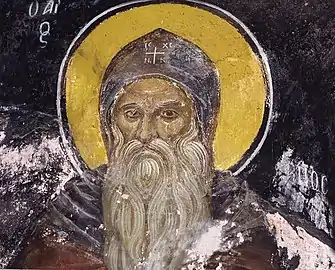
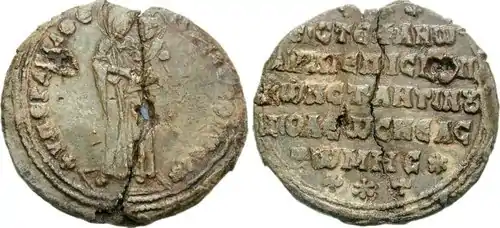 Lead seal of "Stephen, Archbishop of Constantinople New Rome" (either of Stephen I or Stephen II).
Lead seal of "Stephen, Archbishop of Constantinople New Rome" (either of Stephen I or Stephen II).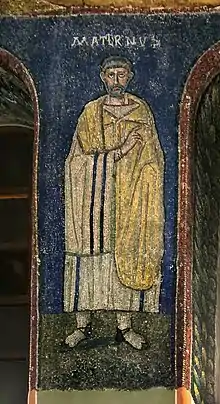 St. Maternus, Bishop of Milan.
St. Maternus, Bishop of Milan. Relief of St. Philastrius (right side).
Relief of St. Philastrius (right side).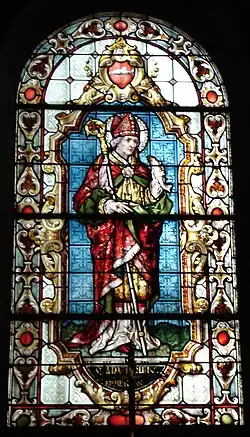 St. Arnulf of Metz.
St. Arnulf of Metz.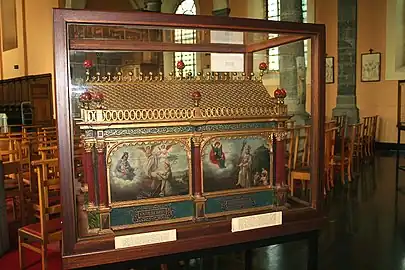 Reliquary of St. Frederick of Utrecht, martyr bishop.
Reliquary of St. Frederick of Utrecht, martyr bishop. Venerbale John the Much-suffering, of the Kiev Caves.
Venerbale John the Much-suffering, of the Kiev Caves.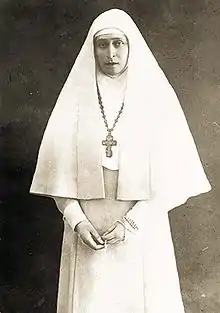 New Martyr Abbess Elizabeth (Romanova), Grand Duchess of Russia.
New Martyr Abbess Elizabeth (Romanova), Grand Duchess of Russia..jpg.webp) Nun Barbara (Yakovleva).
Nun Barbara (Yakovleva).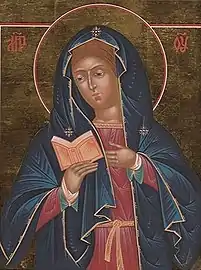 Icon of the Mother of God "Kaluga".
Icon of the Mother of God "Kaluga".
Notes
- The notation Old Style or (OS) is sometimes used to indicate a date in the Julian Calendar (which is used by churches on the "Old Calendar").
The notation New Style or (NS), indicates a date in the Revised Julian calendar (which is used by churches on the "New Calendar"). - "At Dorostorum, in Mysia, in the time of Julian the Apostate and the governor Capitolinus, St. Æmilian, martyr, who was cast into a furnace, and thus received the palm of martyrdom."[6]
- Name days celebrated today include:
- Emilianos, Emilio (Αἰμιλιανός, Αἰμίλιος);
- Emiliani, Emilia (Αἰμιλιανή, Αίμιλία).
- "At Tivoli, in the time of the emperor Adrian, St. Symphorosa, wife of the martyr St. Getulius, with her seven sons, Crescens, Julian, Nemesius, Primitivus, Justinus, Stacteus, and Eugenius. Their mother, because of her invincible constancy, was first buffeted a long time, then suspended by her hair, and lastly thrown into the river with a stone tied to her body. Her sons had their limbs distended by pulleys and bound to stakes, and terminated their martyrdom by different kinds of death. The bodies were subsequently taken to Rome, and were found in the sacristy of St. Angelo in Piscina."[6]
- "In Spanish Galicia, St. Marina, virgin and martyr."[6]
- "At Carthage, St. Gundenes, virgin. By order of the proconsul Rufinus, she was four different times stretched on the rack for the faith of Christ, horribly lacerated with iron hooks, confined for a long time in a filthy dungeon, and finally put to the sword."[6]
- He suffered a great deal during the persecution of Diocletian, but survived and reposed in peace.
- "At Milan, in the reign of Maximian, the holy bishop Maternus. For the faith of Christ and the church entrusted to him, he was thrown into prison and often scourged. Finally he went to his rest in the Lord with a great renown for his repeated confession of the faith."[6]
- "At Forlimpopoli, in Æmilia, St. Ruffillus, bishop of that city."[6]
- He wrote a book against the Arians which still exists. His successor, St Gaudentius, praised him for his 'modesty, quietness and gentleness towards all men' and for his love for the poor.
- "At Brescia, the birthday of St. Philastrius, bishop of that city, who in speech and writing combated heretics, especially the Arians, from whom he suffered much. Finally, he died in peace, renowned for miracles."[6]
- "ST. GONERI, the hermit, was a native of Great Britain, and a priest, who withdrew to Brittany to seek a life of solitude. His first retreat was near Rohan, in the diocese of Vannes; but his miracles having discovered his sanctity, he quitted the spot and took refuge in the district of Tréguier, where he lived in perfect seclusion till the time of his blessed death. There is an ancient chapel at Plougrescant built over the place of his burial, and in it are still preserved with veneration considerable portions of his sacred relics."[24]
- A courtier of high standing in the palace of the Austrasian kings, he decided to become a monk at Lérins. His wife became a nun and Arnulf was on the point of going to Lérins when he was made Bishop of Metz (c 616). A few years before his death he finally managed to go and live as a hermit.
- "At Metz, in France, St. Arnulf, a bishop illustrious for holiness and the gift of miracles. He chose an eremitical life, and ended his blessed career in peace."[6]
- Her relics were later transferred from Adderbury (Edburgh's burgh) in Oxfordshire in England to Bicester.
- Bishop of Utrecht in Holland from 820 on, he was murdered while in church in Maastricht.
- See: (in Russian) Иоанн Многострадальный. Википедии. (Russian Wikipedia).
- The 300 Allemagne Saints came to Cyprus from Palestine, and lived as ascetics in various parts of the island. According to some of their lives in the Great Synaxaristes, after the dissolution of the Second Crusade (1147 - 1149), they decided to live the monastic life in the Jordan desert. However since the Latins there disturbed them, they relocated to Cyprus and dispersed over the island.
- See: (in Russian) Калужская икона Божией Матери. Википедии. (Russian Wikipedia).
- See: (in Russian) Горицкий Воскресенский монастырь. Википедии. (Russian Wikipedia).
References
- July 18/July 31. Orthodox Calendar (PRAVOSLAVIE.RU).
- (in Greek) Συναξαριστής. 18 Ιουλίου. ECCLESIA.GR. (H ΕΚΚΛΗΣΙΑ ΤΗΣ ΕΛΛΑΔΟΣ).
- Great Synaxaristes: (in Greek) Ὁ Ἅγιος Αἰμιλιανὸς ὁ Μάρτυρας. 18 ΙΟΥΛΙΟΥ. ΜΕΓΑΣ ΣΥΝΑΞΑΡΙΣΤΗΣ.
- Martyr Emilian of Silistria in Bulgaria. OCA - Lives of the Saints.
- (in Russian) ЕМИЛИАН. Православная Энциклопедия под редакцией Патриарха Московского и всея Руси Кирилла (электронная версия). (Orthodox Encyclopedia - Pravenc.ru).
- The Roman Martyrology. Transl. by the Archbishop of Baltimore. Last Edition, According to the Copy Printed at Rome in 1914. Revised Edition, with the Imprimatur of His Eminence Cardinal Gibbons. Baltimore: John Murphy Company, 1916. pp. 211-212.
- Great Synaxaristes: (in Greek) [Ὁ Ἅγιος Μάρκελλος ὁ Μάρτυρας Ὁ Ἅγιος Μάρκελλος ὁ Μάρτυρας]. 18 ΙΟΥΛΙΟΥ. ΜΕΓΑΣ ΣΥΝΑΞΑΡΙΣΤΗΣ.
- July 18. The Year of Our Salvation - Holy Transfiguration Monastery, Brookline, Massachusetts.
- July 31 / July 18. HOLY TRINITY RUSSIAN ORTHODOX CHURCH (A parish of the Patriarchate of Moscow).
- Great Synaxaristes: (in Greek) Οἱ Ἅγιοι Δάσιος καὶ Μάρων οἱ Μάρτυρες. 18 ΙΟΥΛΙΟΥ. ΜΕΓΑΣ ΣΥΝΑΞΑΡΙΣΤΗΣ.
- Great Synaxaristes: (in Greek) Οἱ Ἅγιοι Παῦλος, Οὐαλεντίνη καὶ Θέη (ἢ Θόη) οἱ Μάρτυρες. 18 ΙΟΥΛΙΟΥ. ΜΕΓΑΣ ΣΥΝΑΞΑΡΙΣΤΗΣ.
- Great Synaxaristes: (in Greek) Ὁ Ἅγιος Ὑάκινθος ὁ Μάρτυρας ἀπὸ τὴν Ἀμάστριδα. 18 ΙΟΥΛΙΟΥ. ΜΕΓΑΣ ΣΥΝΑΞΑΡΙΣΤΗΣ.
- Martyr Hyacinthus of Amastridea. OCA - Lives of the Saints.
- (in Russian) ИАКИНФ. Православная Энциклопедия под редакцией Патриарха Московского и всея Руси Кирилла (электронная версия). (Orthodox Encyclopedia - Pravenc.ru).
- Great Synaxaristes: (in Greek) Ὁ Ὅσιος Παμβῶ. 18 ΙΟΥΛΙΟΥ. ΜΕΓΑΣ ΣΥΝΑΞΑΡΙΣΤΗΣ.
- Venerable Pambo the Hermit of Egypt. OCA - Lives of the Saints.
- Great Synaxaristes: (in Greek) Ὁ Ἅγιος Ἀθανάσιος ὁ Ρωμαῖος Συγκλητικός, ὁ ἐν Κλύσματι. 18 ΙΟΥΛΙΟΥ. ΜΕΓΑΣ ΣΥΝΑΞΑΡΙΣΤΗΣ.
- Great Synaxaristes: (in Greek) Ὁ Ὅσιος Βαρλαὰμ ὁ ἀναχωρητὴς κοντὰ στὴν Ἀντιόχεια. 18 ΙΟΥΛΙΟΥ. ΜΕΓΑΣ ΣΥΝΑΞΑΡΙΣΤΗΣ.
- (in Greek) 18/07/2023. Ορθόδοξος Συναξαριστής.
- Great Synaxaristes: (in Greek) Ὁ Ἅγιος Ἰωάννης Μητροπολίτης Χαλκηδόνος. 18 ΙΟΥΛΙΟΥ. ΜΕΓΑΣ ΣΥΝΑΞΑΡΙΣΤΗΣ.
- Great Synaxaristes: (in Greek) Ὁ Ἅγιος Στέφανος Ἀρχιεπίσκοπος Κωνσταντινουπόλεως. 18 ΙΟΥΛΙΟΥ. ΜΕΓΑΣ ΣΥΝΑΞΑΡΙΣΤΗΣ.
- July 18. Latin Saints of the Orthodox Patriarchate of Rome.
- Rev. Sabine Baring-Gould (M.A.). "SS. SYMPHOROSA AND HER SEVEN SONS, MM. (CIRC. A.D. 125.)." In: The Lives of the Saints. Volume the Eighth: July - Part II. London: John C. Nimmo, 1898. pp. 432-433.
- Rev. Richard Stanton. A Menology of England and Wales, or, Brief Memorials of the Ancient British and English Saints Arranged According to the Calendar, Together with the Martyrs of the 16th and 17th Centuries. London: Burns & Oates, 1892. pp. 346-347.
- Rev. Sabine Baring-Gould (M.A.). "S. ARNULF, B. OF METZ. (A.D. 640.)." In: The Lives of the Saints. Volume the Eighth: July - Part II. London: John C. Nimmo, 1898. pp. 435-436.
- Very Rev. John O'Hanlon. "ARTICLE I.—ST. THENNA, THENOG, THENEW, OR THANAW, AT GLASGOW, SCOTLAND. [FIFTH AND SIXTH CENTURIES.]". In: Lives of the Irish Saints: With Special Festivals, and the Commemorations of Holy Persons. VOL. VII. Dublin, 1875. pp. 262-265.
- Rev. Sabine Baring-Gould (M.A.). "S. THENEW, MATR. (A.D. 514.)." In: The Lives of the Saints. Volume the Eighth: July - Part II. London: John C. Nimmo, 1898. pp. 433-434.
- Rev. Sabine Baring-Gould (M.A.). "S. FREDERICK, B.M. (A.D. 838.)." In: The Lives of the Saints. Volume the Eighth: July - Part II. London: John C. Nimmo, 1898. pp. 437-441.
- Very Rev. John O'Hanlon. "Article II.—Minnborinus, Abbot of St. Martin's Monastery, Cologne. [Tenth Century.]". In: Lives of the Irish Saints: With Special Festivals, and the Commemorations of Holy Persons. VOL. VII. Dublin, 1875. pp. 265-267.
- Great Synaxaristes: (in Greek) Ὁ Ὅσιος Ἰωάννης τοῦ Πολύτλα ὁ ἔγκλειστος ὁ ἐν Κιέβῳ σπηλαίου (Ρῶσος). 18 ΙΟΥΛΙΟΥ. ΜΕΓΑΣ ΣΥΝΑΞΑΡΙΣΤΗΣ.
- Venerable John the Long-Suffering of the Kiev Near Caves. OCA - Lives of the Saints.
- (in Russian) ИОАНН. Православная Энциклопедия под редакцией Патриарха Московского и всея Руси Кирилла (электронная версия). (Orthodox Encyclopedia - Pravenc.ru).
- Great Synaxaristes: (in Greek) Οἱ Ἅγιοι Ὀνησιφόρος, Παμμέγιστος, Παμφοδίτης, Παφνούτιος, Πηγῶν, Πολέμιος, Σωζόμενος, Σωτήριχος καὶ Φώτιος. 18 ΙΟΥΛΙΟΥ. ΜΕΓΑΣ ΣΥΝΑΞΑΡΙΣΤΗΣ.
- Venerable Pambo the Recluse of the Kiev Far Caves. OCA - Lives of the Saints.
- Hieromartyr Kozman. OCA - Lives of the Saints.
- Grand Duchess Elizabeth OCA - Lives of the Saints.
- Nun-martyr Barbara. OCA - Lives of the Saints.
- Great Synaxaristes: (in Greek) Ἀνακομιδὴ Τιμίων Λειψάνων Ὁσίου Λαζάρου τοῦ Γαλησιώτου. 18 ΙΟΥΛΙΟΥ. ΜΕΓΑΣ ΣΥΝΑΞΑΡΙΣΤΗΣ.
- Icon of the Mother of God of Tolga. OCA - Lives of the Saints.
Sources
- July 18/July 31. Orthodox Calendar (PRAVOSLAVIE.RU).
- July 31 / July 18. HOLY TRINITY RUSSIAN ORTHODOX CHURCH (A parish of the Patriarchate of Moscow).
- July 18. OCA - The Lives of the Saints.
- July 18. The Year of Our Salvation - Holy Transfiguration Monastery, Brookline, Massachusetts.
- The Autonomous Orthodox Metropolia of Western Europe and the Americas (ROCOR). St. Hilarion Calendar of Saints for the year of our Lord 2004. St. Hilarion Press (Austin, TX). p. 53.
- The Eighteenth Day of the Month of July. Orthodoxy in China.
- July 18. Latin Saints of the Orthodox Patriarchate of Rome.
- The Roman Martyrology. Transl. by the Archbishop of Baltimore. Last Edition, According to the Copy Printed at Rome in 1914. Revised Edition, with the Imprimatur of His Eminence Cardinal Gibbons. Baltimore: John Murphy Company, 1916. pp. 211–212.
- Rev. Richard Stanton. A Menology of England and Wales, or, Brief Memorials of the Ancient British and English Saints Arranged According to the Calendar, Together with the Martyrs of the 16th and 17th Centuries. London: Burns & Oates, 1892. pp. 346–347.
- Greek Sources
- Great Synaxaristes: (in Greek) 18 ΙΟΥΛΙΟΥ. ΜΕΓΑΣ ΣΥΝΑΞΑΡΙΣΤΗΣ.
- (in Greek) Συναξαριστής. 18 Ιουλίου. ECCLESIA.GR. (H ΕΚΚΛΗΣΙΑ ΤΗΣ ΕΛΛΑΔΟΣ).
- (in Greek) 18/07/2023. Ορθόδοξος Συναξαριστής.
- Russian Sources
- (in Russian) 31 июля (18 июля). Православная Энциклопедия под редакцией Патриарха Московского и всея Руси Кирилла (электронная версия). (Orthodox Encyclopedia - Pravenc.ru).
- (in Russian) 18 июля по старому стилю / 31 июля по новому стилю. СПЖ "Союз православных журналистов". 2023.
- (in Russian) 18 июля (ст.ст.) 31 июля 2023 (нов. ст.). Русская Православная Церковь Отдел внешних церковных связей. (DECR).
This article is issued from Wikipedia. The text is licensed under Creative Commons - Attribution - Sharealike. Additional terms may apply for the media files.

